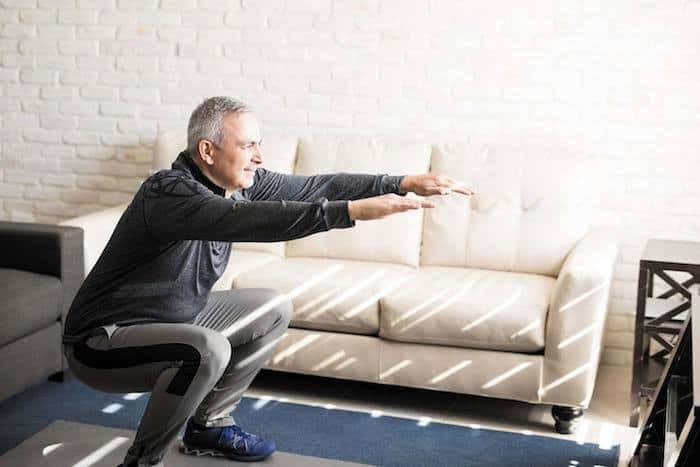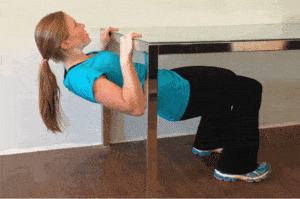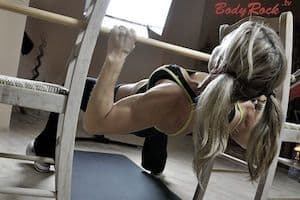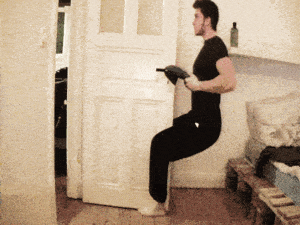Short Home Workouts You Can Do Now With Surprising Results

You’re equipped for home workouts if you have a home and a body. Choose a 4, 7 or 10-minute workout, do it with intensity, and marvel at the surprising results. Watch the videos.
You have three home workouts from which to choose of varying duration:
- 4 minutes
- 7 minutes
- 10 minutes
Of course, you can do more than one round of each, or combine them, if you have the energy, because even though these home workouts are short in duration, their intense if properly done.
Also, there’s:
- A comprehensive resistance band workout, and
- A mountain.
The aim is to have an exercise suitable for everybody. You decide what type of home workouts you’re willing to do, and their duration. To help ensure that you do them on a regular basis — and make it fun — enlist a buddy to join you, either someone in your home, or via a video sharing app, such as Xoom, FaceTime or WhatsApp video.
Here’s what’s covered:
Focus On Your Heart Rate
As you’ll soon see, these home-based workouts require an effort that’s measured by heart rate. We’re looking to go well beyond the aerobic threshold, typically guided by the ability to talk while performing the exercise. That’s not possible during an anaerobic routine, where our focus is on getting your heart rate as high as 90% of maximum capacity.
How can you tell what’s 90% of your maximum heart rate?
Use this chart guide you:
I didn’t find a chart with a 90% of maximum heart rate column, or with age groups above 70 years. If you yearn to get to 90% of your maximum heart rate, multiply the 100% number by 0.10 and subtract that from the max number. For example: 200 x 0.10 = 20; 200 – 20 = 180, which is 90% of 200. Or if you’re good at multiplying by 9, just do 0.9 x your-max-heart-rate.
If you’re over 70 years of age, use this formula:
If you don’t have a way to monitor your heart rate, such as with a chest band or watch, to ascertain how fast 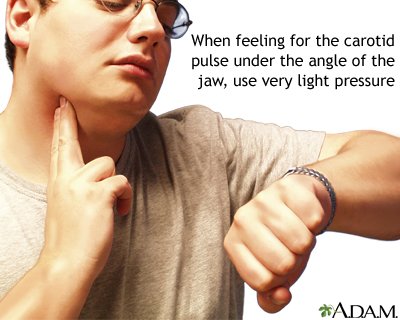 your heart is beating:
your heart is beating:
- Place two fingers against the side your throat and find your pulse.
- Count the heart beats for six seconds.
- Multiply 6 x 10 to get your beats per minute.
This can be awkward to do while your doing a near-all-out sprint of some kind (especially if you’re jumping rope). My recommendation is that you get a sense for what 90% (or whatever your target) is of your maximum heart rate by counting your pulse a few times and then rely on that body awareness.
HIIT It Hard for Your Home Workouts
HIIT refers to High-intensity interval training. It’s become popular because short bursts of strenuous exercise can have a big, positive impact on the body. HIIT concentrates the heart, lungs and metabolism benefits of, say, a 20-minute jog into a few minutes.
So, yes, you can save a lot of time with HIIT exercises, but there is a price — it’s grueling, if you do it right. Here’s how you know if you’re doing HIIT properly:
- By the time the HIIT cycle is done, your heart is pounding near its maximum capacity and you’re gasping for breath.
- You can only do a few cycles before you’re completely gassed.
- You don’t injure yourself.
That last point is worth underscoring, especially as you get older and become more injury prone and take longer to recover:
- If you’re not an accomplished runner, don’t make your HIIT exercise routine sprinting, as in Usain Bolt.
- Choose exercises that are easy on the joints, such as biking or swimming. (I find running stairs is easier on my body than sprinting on flat ground.)
- If you’re new to HIIT, prepare yourself as needed before going all out by beginning at 50% effort and increasing the intensity gradually.
You may apply HIIT to many of the aerobic activity you like, such as running (but remember my words of caution), biking, stair climbing, swimming, jumping rope and/or rowing.
According to exercise physiologist Dr. Phil Campbell, the most effective HIIT regimen is:
- 30 seconds of all-out effort;
- Followed by 90 seconds of active rest;
- Done eight times.
Note:
4 Minutes for Minimalists
Less can be more if you perform your exercise anaerobically and consistently. By definition, an anaerobic exercise is activity in which the body incurs an oxygen debt. You experience this as huffing and puffing. When that happens while exercising, say between 30 seconds and a few minutes, the exercise is anaerobic and has taxed some large muscles, such as your legs and/or the chest and back.
Norwegian scientists have studied the effects of intense intervals lasting for four minutes, performed at about 90% of each volunteer’s maximum heart rate and repeated four times, with a three-minute rest between each interval, bringing the total time of exercise to 16 minutes. The researchers found that high-intensity aerobic interval training resulted in significantly increased VO2max compared with long slow distance and lactate-threshold training intensities.
OK, but still we’re really talking 16 minutes here, not four. Yes, but just four minutes is valuable.
The Norwegians did another study that compared the results of four minutes done four times in one exercise session described above to just one four minute session performed at 90% of maximum heart rate three times a week for 10 weeks. Remarkably, the exercisers improved their endurance, blood sugar control and blood pressure as much as a comparable group of men who did a series of all-out exercise lasting for 16 minutes.
Least you get all giddy thinking that you only need to putz around for four minutes to achieve these results, let me disabuse you of that notion. Those four minutes are very, very hard. If you’re not used to sprinting or doing HIIT, you need to build up to such an effort. Certainly, it’s counterproductive to enthusiastically push too hard and wind up injuring yourself.
Exercise(s) to Try:
Depending on your conditioning, walk, jog or sprint up stairs, use a bike or jump rope. Do it for four minutes. Extra credit: After a three minute rest, do it again.
7 Minutes for the Fat Burn
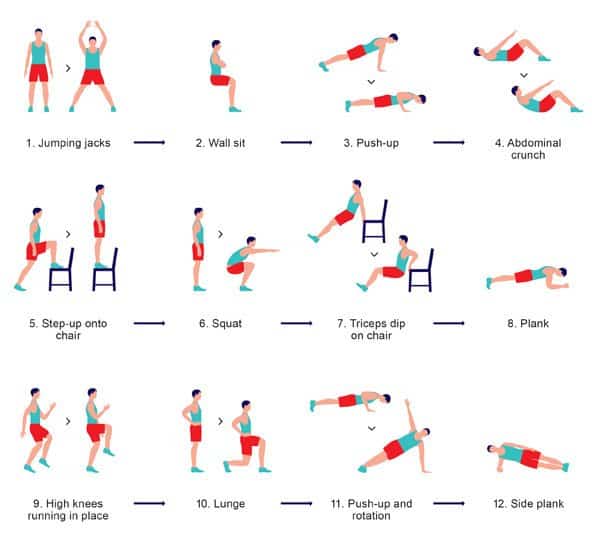 Seven minutes is all you may need to get fit if you use a specific sequence of exercises in a certain way.
Seven minutes is all you may need to get fit if you use a specific sequence of exercises in a certain way.
An article in the May-June issue of the American College of Sports Medicine’s Health & Fitness Journal shows that 12 exercises deploying only body weight, a chair and a wall fulfills the latest mandates for high-intensity effort, which distills down to seven minutes of steady discomfort.
This seven minute exercise sequence, is referred to as “High Intensity Training Circuit” (HITC), which you perform each exercise in rapid succession, allowing 30 seconds for each. Your intensity level should hover at around an eight on a discomfort scale of 1 to 10, says the creator of this exercise routine, Chris Jordan, the director of exercise physiology at the Human Performance Institute in Orlando, Fla.
Some proven benefits of HITC training:
- A fast and efficient way to lose excess body weight and body fat.
- When resistance training exercises using multiple large muscles are used with very little rest between sets, they can elicit aerobic and metabolic benefits. Research has found that these metabolic benefits can be present for up to 72 hours after a high-intensity exercise bout has been completed.
- There also may be a greater impact on subcutaneous fat loss with high-intensity intermittent circuit-style resistance training protocols than with traditional steady state sustained-effort aerobic work or traditional resistance training. This is thought to be from the increased level of catecholamines and growth hormone found in the blood both during and after high-intensity resistance training exercise with shortened rest periods (less than 30 seconds).
- HICT may be an extremely effective and efficient means by which to increase an individual’s V˙O2max, a well-established marker of cardiopulmonary health. When HICT protocols have been compared with traditional steady state protocols in the laboratory, HICT elicits similar and sometimes greater gains in V˙O2max, despite significantly lower exercise volume.
- HICT can be an efficient approach to decreasing insulin resistance as well — a major factor in developing type 2 diabetes. Positive changes have been observed in insulin resistance in as little as 8 minutes per week when executed at an intensity more than 100% V˙O2max.
(Go here to see the studies backing these claims.)
Click here for a video of one man's 7-minute experience
Something for the back
10 Minutes for Endurance
This workout option might be good for you if you like to run, bike, row or swim.
Typically, you might have done any of these exercises for their aerobic effect, rather than increasing the intensity, but reducing the time to achieve an anaerobic effect. (Read about the difference.) But now, it focus is intensity over a short duration — one minute.
In one study, overweight, sedentary volunteers completed this 10-minute workout three times a week — for a total of 30 minutes of exercise weekly. After six weeks, the volunteers had improved their endurance by 12%.
In this exercise regimen, there’s a total of one minute of intense exercise scattered within a 10-minute duration.
Do it in seven steps:
- Warm up for 2 minutes.
- Pedal, run or swim all-out for 20 seconds.
- Pedal, run or swim slow and easy for 2 minutes.
- Pedal, run or swim all-out for 20 seconds.
- Pedal, run or swim slow and easy for 2 minutes.
- Pedal, run or swim all-out for 20 seconds.
- Cool down for 3 minutes.
Exercise Routine Frequency
Do You Have Resistance Bands?
So far, we’ve been examining home workouts using equipment you probably already have, such as your body, a set of stairs, or jump rope. But if you have exercise bands, or are willing to purchase some, you can expand the type of exercises you can do right at home.
In this we’re guided by a video done by Coop from Garage Gym Reviews:
Here’s a list of band you could use:
- Leekey (the ones I have and really like)
- WODFitters
- Epitomie
Do You Have A Mountain Nearby?
About five years ago, I plodded behind my good friend and Swiss mountaineer, Anatole, as we hiked up a section of Mt. Rainier in Washington state.
While this isn’t among a list of home workouts, per se, if you’ve got a big hill or mountain nearby, go hike up it. You can go slow and steady to gain some aerobic conditioning, or do fast anaerobic spurts. As you’ll see in the video, it was all I could do to simply slowly put one foot in front of another to keep up with Anatole.
Your Takeaway
Remember this one thing:
Choose a workout and do it regularly with someone who will hold you accountable.
Yup.
Last Updated on February 13, 2021 by Joe Garma

